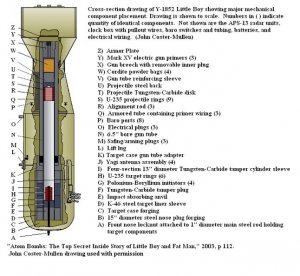Yes, I remember the era. The prospectors used Scintillators and Geiger Counters. I have a Geiger Counter and a radioactive mineral sample.
The Scintillator detected Gamma radiation from a distance, while the Geiger Counter measured the Alpha radiation from the ore sample.
There are many radioactive minerals beside Uranium. They are all above 92 on the Periodic Chart of the Elements.
Uranium is important because it has the highly fissionable isotope U-235, which is used as bomb material.
This isotope occurs in just 0.7% of natural Uranium U-238. By far the greatest cost of the Manhattan Project was in seperating
U-235 from U-238.
The Hiroshima bomb ("Little Boy") contained 140 pounds of weapons-grade U-235, but only 3 pounds actually fissioned!
Yet this was enough to flatten Hiroshima and kill 70,000 Japanese civilians in a split second from heat, radiation, and blast.
The cost of the uranium for Litttle Boy was $500 million in 1945 dollars.
(The red-colored parts "S" and "H" represent the U-235 that destroyed Hiroshima.)
Hal


